Rotterdam Toen - Keezending EarthCache
Rotterdam Toen - Keezending
-
Difficulty:
-

-
Terrain:
-

Size:  (other)
(other)
Related Web Page
Please note Use of geocaching.com services is subject to the terms and conditions
in our disclaimer.
Rotterdam Toen - Keezending

Wat vele nog niet weten is, dat het
ultramoderne station Blijdorp is verrezen op een historische plek.
In 1787 stond op deze plaats een poldergemaal met een stoommachine
naar het ontwerp van James Watt. Dat was toen een
wereldprimeur!
Op 8 september 1787 werd het gemaal, dat de polder Blijdorp droog
moest houden, voor het eerst onder stoom gebracht. Rond 1800 is het
gemaal dat ook bekend staat als
Keezending, afgebroken. |
What many do not know is that the
ultra-modern Blijdorp station is built on a historic site. On
this spot stood in 1787 a polder pumping station with a steam
engine after the design of James Watt. This was the first on
European mainland
On September 8, 1787, they steamed up the pumping station for the
first time in order to keep the Blijdorp polder dry. Around 1800,
the pumping station, also known as
Keezending, demolished. |

Het perronniveau van het station bevindt
zich op de bovenkant van de Pleistocene ondergrond van
Rotterdam, op ca 20 meter onder de grond. Na de laatste IJstijd,
circa 10.000 jaar geleden, werd het klimaat warmer werd en begon de
zeespiegel te stijgen. We spreken vanaf die tijd van het
Holoceen.
Het oude landschap verdronk en op de zandondergrond werden in het
Holoceen door rivieren en de zee dikke pakketten klei en zand
afgezet. De laatste paar duizend jaar, tot aan de middeleeuwse
ontginningen, circa 1000 AD, vond er op deze plaats vooral
veenvorming plaats in moerassen. Door de ontginning en ontwatering
van het veengebied zakte het landschap uiteindelijk in tot beneden
de zeespiegel en moesten er dijken worden aangelegd om droge voeten
te houden. Zo ontstond de polder Blijdorp. |
The platform level of the station is on
the top of the Pleistocene subsoil of Rotterdam, at
approximately 20 meters below ground. After the last Ice Age about
10,000 years ago, the climate warmed and sea levels began to rise.
From that time we speak of the Holocene time.
The ancient landscape and drowned on the sand surface were thick
packages of clay and sand deposited by the sea and rivers. In the
last few thousand years, to the medieval reclamations, around 1000
AD, took place at this particular place in the formation of peat
swamps. By farming and dewatering the peat landscape eventually
dropped to below sea level and dikes had to be built to keep
feet dry. Thus the polder Blijdorp was born. |

| Lokatie Keezending op een kaart uit 1909
/ Location Keezending on the map of 1909 |
De Blijdorpse polder, waarnaar de wijk
Blijdorp en de Diergaarde Blijdorp zijn genoemd, ligt in het
noorden van Rotterdam.
De oorspronkelijke polder was veel groter en omvatte behalve het
gebied dat nu door de wijk Blijdorp wordt ingenomen, het hele
gebied tussen Overschie, De Delfshavense Schie en de
Beukelsdijk.
De periode tot 1150
Het veelal veenachtige gebied was ontgonnen en bewoond, maar
mogelijk nog onbedijkt. In de bouwput van het Station Blijdorp zijn
de resten van een boerderij uit deze periode opgegraven. Er vonden
regelmatig overstromingen plaats.
Rond 1200 werd het gebied bedijkt en was er sprake van de Bridorpse
polder, wat vermoedelijk later verbasterd is naar Blydorpsche
polder en weer later naar de hedendaagse Blijdorpse polder.
In het begin werd de polder drooggehouden door bij eb de sluizen te
openen. Later, vanaf de 15e eeuw, werden er windmolens ingezet. Het
experiment met het stoomgemaal aan het einde van de 18e eeuw vormde
op termijn het einde van de bemaling met windmolens. Vanaf het
midden van de 19e eeuw wordt het gebied machinaal drooggehouden
(eerst mbv stoom, later met diesel of elektrische bemaling). |
The Blijdorp polder, which the district
and the Rotterdam Blijdorp Zoo are named after, lies in the north
of Rotterdam.
The original polder was much larger and included not only the area
now occupied by the Blijdorp district but also the whole area
between Overschie, De Delfshavense Schie and the Beukelsdijk.
The period until 1150
The often peaty area was largely uninhabited and outside the dikes.
During the excavation of the Blijdorp station they found the
remains of a farmhouse. In this area regular flooding
occurred.
Around 1200 the dikes were completed and the Bridorpse polder
arose, which is probably later corrupted to Blydorpsche polder and
later to the Blijdorpse polder.
In the beginning the polder stayed dry by opening the locks and
barriers at low tide. Later, from the 15th century, windmills were
used. The experiment with the pumping station at the end of the
18th century, was eventually the end of the drainage with
windmills. From the mid-19th century, the area is kept dry machine
(first using steam, diesel or electric pumping later). |
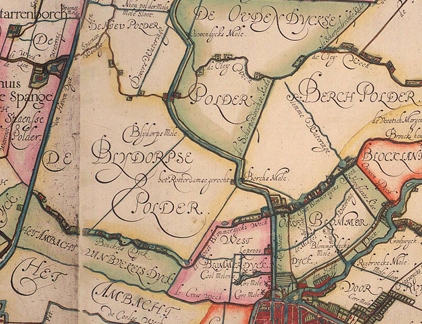
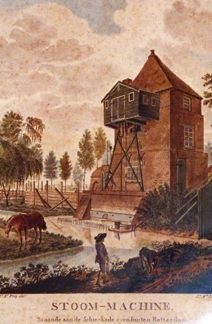
| Blijdorpse Polder anno 1611 |
Keezending |
De periode vanaf 1150 tot
1880
In deze periode hadden de steden Delft, Rotterdam en Schiedam onmin
over de waterwegen en de bijbehorende tolheffing. In de periode
1150 en 1389 werden er verschillende Schiekanalen gegraven waardoor
verdere polders in het gebied ontstonden.
Door het graven van de Rotterdamse Schie in 1344 ontstonden er twee
polders: Blydorpsche Polder en Bergsche Polder. De Rotterdamse
Schie liep waar nu de Stadhoudersweg en de Schiekade lopen. Het
gebied maakte deel uit van de zelfstandige gemeente Overschie. |
The period from 1150 to
1880
In this period the cities of Delft, Rotterdam and Schiedam quarrel
about the waterways and the toll income. They dug various Schie
channels between 1150 and 1389; thereby also further polders arose
in this area.
By digging the Schie in Rotterdam in 1344 there emerged two
polders: the Blydorpsche Polder and the Bergsche Polder. The
Rotterdam Schie was where the present the Stadhoudersweg and
Schiekade are. The area was part of the independent municipality
Overschie. |
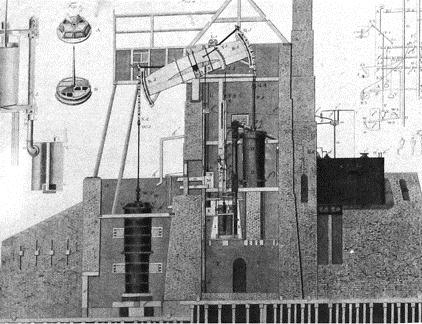

| Stoomgemaal / Steam Pumping System |
Keezending |
Het stoomgemaal
Steven Hoogendijk, een Rotterdamse klokkenmaker, had in 1775 een
mislukte proef bij de Oostpoort van Rotterdam gedaan met een
stoomgemaal.
Hoogendijk zette echter door en kreeg toestemming van het
polderbestuur om in de Blijdorpse polder een stoomgemaal met een
machine van “Boulton en Watt” uit Engeland te bouwen en
op 15 september 1787 werd deze na ruim een jaar bouwen in bedrijf
genomen. Het debiet bedroeg 1750 kubieke voet per minuut.
In de polders Cool, Schoonderloo en Blommerswijk was in datzelfde
jaar sprake van grote wateroverlast en door verbindingen te maken
met dit stoomgemaal kon het water in 1½ maand weggepompt worden tot
onder het zomerpeil. Toch vonden de ingelanden (boeren) van deze
polders het gemaal te duur en namen het niet over. Het gemaal werd
in 1791 weer ontmanteld.
Omdat Steven Hoogendijk tot de partij van de Patriotten
(scheldnaam: Keezen) behoorde, werd het gemaal door de
Oranjegezinde boeren ook wel "Keezending" genoemd. Uiteindelijk
bleek het succes toch groot genoeg om in andere delen van het land
stoombemaling op gang te brengen. |
The steam pumping
station
In 1775 Steven Hoogendijk, a Rotterdam clockmaker, had failed a
test at the Rotterdam east gate with a steam pumping station.
However, Hoogendijk continued and received permission from the
government to built one of “Boulton and Watt” steam
pumping station from England in the Blijdorpse polder. On 15
September 1787, a year after they started building, it was ready to
operate. The capacity was 1750 cubic feet per minute.
In the same year the districts Cool, Schoonderloo and Blommerswijk
had major floodings and connecting by this pumping station the
water was pumped in 1 ½ months to below the summer level. But the
landholders and farmers of these polders thought is was too
expensive and did not take it over. The pumping station was
decommissioned in 1791.
As Steven Hoogendijk belonged to the party of the Patriots (so
called: Keezen) the farmers of the Orange party called the steam
pumping station “Keezending”.
Ultimately, the success nevertheless was large enough to steam
pumping stations in other parts of the country |
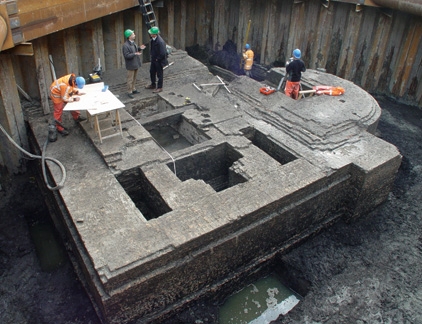
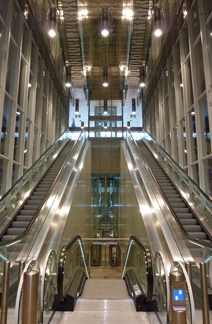
| Fundamenten Keezending / Fundamens
Keezending |
Blijdorp Station |
| In oktober 2004 werden de restanten van
de fundering verwijderd uit wat nu het Statenwegplantsoen is, om
ruimte te maken voor de boortunnel voor de aanleg van de
RandstadRail. |
In October 2004 the remains were removed
from the foundation of what is now the Statenwegplantsoen to make
room for the tunnel serving RandstadRail |
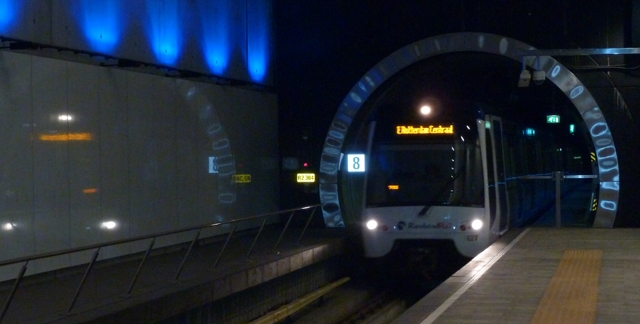
Earth Cache
Om te loggen moet je dit fantastische station bezoeken en op
perronniveau vind je de plaquettes die aan het stoomgemaal
herinneren.
Beantwoord de volgende vragen:
A: op de plaat “Pionieren in de polder” staat onderaan
een quote, wat is het tweede woord?
B: hoe groot is de diameter van de cilinder in mm
Stuur uw antwoord ovv teamnaam naar:
AB@mar-ine.nl (verwerk je antwoorden in het e-mailadres)
Foto´s zijn welkom |
Earth Cache
In
order to log, you must visit this fantastic station at platform
level and find the plaques at the pumping station.
Answer the following questions:
A: On the panel “Pionieren in de polder” you will find
a quote. What is the second word?
B: what is size is the cylinder in mm?
Send your answer and your teamname to:
AB@mar-ine.nl (incorporate your answers into the e-mail adres
Pictures are welcome |

Met dank aan:
Bureau Oudheidkundig Onderzoek Rotterdam (BOOR)
Gemeentewerken Rotterdam
Additional Hints
(Decrypt)
Zrg BI-puvc xha wr 20 zvahgra tengvf anne ovaara bs ovw qr yvsg mvwa trra BIpuvc cbbegra (orgerqra bc rvtra evfvpb)
Lbh pna ragre jvgu BI Puvc, va/bhg jvguva 20 zvahgrf vf serr. Be ng gur ryringbe ner ab BIpuvc tngrf (ragre ng lbhe bja evfx)